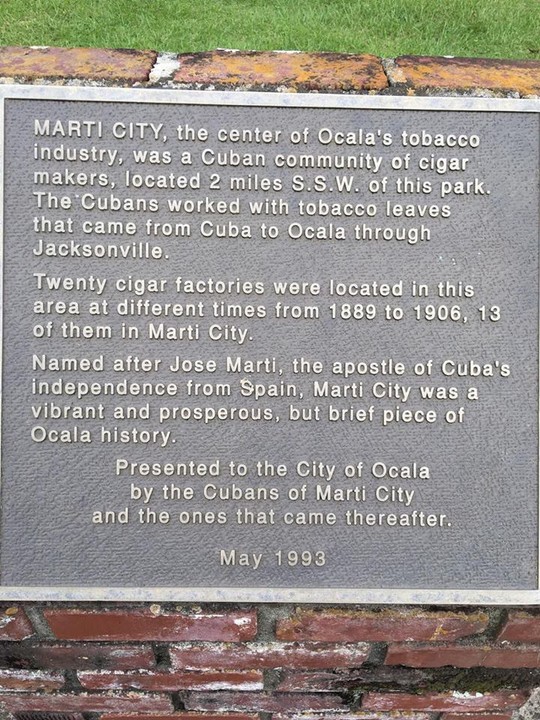Marti City Historical Area
Introduction
Text-to-speech Audio
Images
Commemorative Plaque Honoring Marti City Historical Area

Backstory and Context
Text-to-speech Audio
Marion County was a prosperous area for agriculture in the late nineteenth century. Several rail lines connected to the area and local industry was proficient at shipping goods in this manner. Cigar factories flourished in Cuba and South Florida, but these areas were out of reach of rail lines. Taking advantage of this situation, several Ocala businessmen sought to corner the market by investing in cigar factories in the agriculture-rich Ocala area and using the pre-existing rail lines to ship their products.1 As Cuban people had a tradition of cigar making, Cubans were recruited to staff the factories and Cubans began to immigrate to the area in large numbers.2 Eventually, Marti City was home to more than twenty cigar factories.3
Originally named "Havana Town," the community was renamed "Marti City" after Jose Marti visited the area in 1891. Marti is remembered as the "father of Cuban independence" and is today immortalized in Cuba. He visited the community to collect funds from Cuban expats to fund his war against Spain.4 Not only did the residents of the area donate to Marti, they renamed their community after him.5 After the community was renamed, an election took place and Marti City officially became an independent town.
Soon after the community's first elections, the global cigar trade began to change. Although Marti City was successfully able to access markets by rail across the US, other distributors were even more successful.1 By 1896, most of the cigar factories had closed and most of the Cubans had left. By World War 2, most of the Marti City structures were gone, and today only one house and one store building remain from the time period.3 Yet, although its time was brief, Marti City's impact on the area was an important one. Not only were the cigar factories in Marti City one of the area's first attempts at industrialization, they represent an early interaction between the Marion County area and the greater world of international trade, politics, and culture.
Sources
1. David Cook, “In 1890s, cigar industry flourished, died in Ocala,” Star-Banner, November 29, 2009.
2. “Died, Domingo Yanes,” Ocala Evening Star, December 17, 1895.
3. David Cook, “Sale of Historic Rheinauer building threatens Ocala’s downtown Area,” Ocala. August 16, 2009, ocala.com/news/20090816/sale-of-historic-rheinaur-building-threathens-ocalas-downtown-area.
4. Louis B. Perez, Jr., "Jose Marti in the United States: The Florida Experience," Hispanic American Review 77, 3 (Aug, 1997), 490.
5. Gerald E. Poyo, "With All for All, the Emergence of Cuban Nationalism in the United States," New West Indian Guide 66, 2 (1992), 123.
